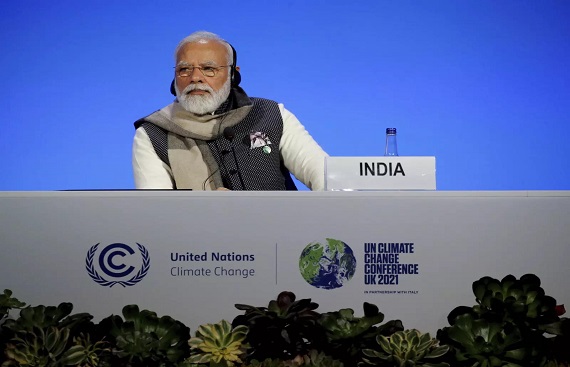COP26: How India can Play a Pivotal Role

The UK is hosting the COP26 UN Climate Change Conference, which began from October 31 to November 12. Leaders from more than 190 countries, thousands of negotiators, citizens, and researchers have participated in the conference to encourage a global response to the threat of climate change. The conference goes into its second week, negotiations on crucial topics are moving forward. Encouraged by a few high-profile announcements at the beginning of the meeting, representatives are upbeat about the prospects for real progress in the fight against global warming. The 26th Conference of the Parties, better known as COP26, is happening in Glasgow, Scotland.
Several leaders have expressed COP26 as a “make or break” deal for the planet. According to the UNFCCC, COP26 will work towards four goals:
- Secure global net-zero by mid-century and keep 1.5 degrees within reach
- Adapt to protect communities and natural habitats
- Mobilize finance
- Work together to deliver
Considering India's agenda at the COP26 Glasgow 2021 climate change conference, the country hopes to accomplish some goals and face some challenges. The fate of humanity perhaps depends on the consequence of COP26.
India’s Best Climate Action
![]()
India is becoming one of the significant contributors, as PM Narendra Modi has announced 2070 as the target for India to reach net-zero carbon emissions. Environment experts say that with the significant promise at COP26, India is rightly demanding $1 trillion from the developed nations.
Aarti Khosla, Director, Climate Trends, said, "By announcing a commitment for achieving net-zero targets by 2070, India has responded positively to the global call, and it was the best climate action in Glasgow."
The WEF's 'Mission 2070: A Green New Deal for a Net-Zero India' report provides a roadmap for India's transition. It asserts that India's transition to a green economy could contribute more than $1 trillion in economic impact by 2030 and create over 50 million jobs.
Energy, mobility, industry, infrastructure and cities, and agriculture are the five pillars contributing over 90 percent of India's emissions that India will require to address along with four cross-sectoral enablers, it added.
These enablers comprise an accelerated approach to green technology innovation, an overarching framework to catalyse green finance, an integrated approach to carbon, capture, utilization, storage, and climate adaptation plan. Furthermore, these pillars and enablers rely on India's continued economic growth, technological development, financial innovation, and strong political leadership.
The green energy transition can also trigger unintended social expenses. Newer technologies can disproportionately affect the land rights of Indigenous communities, women could potentially be left out of the new industries replacing the old, and there is a risk of creating new inequities as the poorest households get stuck paying legacy grid costs.
The WEF report added that India would oblige all stakeholders, including the government, the private sector, investors, and civil society, to step up for the next 'green revolution.'
Samir Saran, Observer Research Foundation president, stated that the report visualizes India becoming the world's first $5 trillion and subsequently $10 trillion 'off-carbon economy.'
Climate Solutions to be a more Prosperous Country
![]()
India denied signing the COP26 pledge to stop deforestation and cut methane gas emissions by 2030. Considering the action, officials notified the nation's concerns over the impact on trade, the country's immense farm segment, and the role of livestock in the rural economy. Around two-thirds of Indians live in the countryside, and India's colossal livestock population is central to its agriculture and village economy. As a member of the World Trade Organization (WTO), any trade-related matter of India should only be analysed by the WTO, stated the official.
Greenhouse gases produced by burning coal are the single most significant player in climate change. Detaching the world off coal is considered critical in limiting temperature rises across the planet. However, the absence of India from the pledge to drop coal has drawn criticism.
Even though India's road to net-zero carbon emissions will be long and challenging, but it's not impossible. Net-zero emissions mean gaining an overall equivalence between greenhouse gas emissions produced and greenhouse gas emissions extracted from the atmosphere, through natural means or by using the still-nascent carbon capture technology. India's vision of net-zero carbon emissions includes some of the significant actions:
- India will develop its renewable energy capacity to 500 gigawatts by 2030;
- Around 50% of its energy requirements would come from renewable sources;
- It will diminish total projected carbon emissions by a billion tonnes between now and 2030;
- India will lessen the carbon intensity of its economy by less than 45%.
Ulka Kelkar, director of the climate program at World Resources Institute, India, said, "the pledges will provide policy certainty to industry to invest in decarbonization technologies, and will also inspire India's states and cities to set their own net-zero pathways to development."
By 2070, India will also be a relatively more prosperous country with a much higher per capita income that will form the fiscal space required for the transition, said Vaibhav Chaturvedi, an economist with climate think-tank Council on Energy, Environment and Water.
India will expect to target the power sector first, as per Chaturvedi. The country has already made progress in its potential for renewable energy through solar and wind.
"The second sector is hydrogen — that is also a big one. The biggest players in India have already entered the market," he added.
Considering the above discussion, India is putting climate change at the center of its policies. Refining on India's record, the prime minister said that in terms of installed renewable energy capacity, India is ranked 4th in the world. India has expanded its non-fossil fuel energy by 25 percent in the last seven years, representing 40 percent of its energy mix.
Given India's tremendous impact on the global economy, India has stepped its path quite carefully while introducing ambitious targets as it's still a developing economy.
